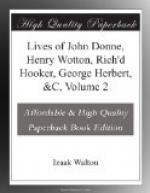[Footnote 18: Let it ever be remembered to the honour of this Prelate, whom Charles I. was wont to call “the good man,” and whom he declared to be his greatest comfort in his most afflictive situation, that he delivered his sentiments without disguise to the King, on the subject of Lord Strafford’s fate, telling him plainly, that “he ought to do nothing with an unsatisfied conscience, upon any consideration in the world.” His character is thus beautifully pourtrayed by Sir Henry Wotton, in a letter to the Queen of Bohemia. “There is in him no tumour, no sourness, no distraction of thoughts; but a quiet mind, a patient care, free access, mild and moderate answers. To this I must add, a solid judgment, a sober plainness, and a most indubitable character of fidelity in his very face; so as there needs not much study to think him both a good man and a wise man.”]
[Footnote 19: This learned person went abroad in 1626, and spent four years in visiting Asia and Africa. He again left England, and travelled over several parts of Europe. He afterwards joined the Parliament against Charles I., whom he was appointed to attend from the very beginning of his imprisonment to the time of his death. He shewed himself a most faithful servant to the King, whose real character he soon discovered to be totally different from that which had been represented to him. In 1660, Charles II. advanced him to the Dignity of a Baronet, by the name of Thomas Herbert of Tinterne, in Monmouth “for faithfully serving his royal father during the two last years of his life.”—In 1678 he published “Threnodia Carolina; containing Memoirs of the two last Years of the reign of King Charles I.” This little work was reprinted in 1813, upon the opening the tomb of the royal martyr, by Mr. G. Nicoll of Pall Mall, with a “sensible and seasonable Preface.” Sir T. Herbert assisted Sir William Dugdale in compiling the third volume of his “Monasticon Anglicanum;” and died at York, his native place, 1682, leaving several MSS. to the public library at Oxford, and others to that of the Cathedral at York.]
[Footnote 20: This is supposed to have been Mr. Swinfen, an ancestor (on the female side) of the late Earl St. Vincent.]
[Footnote 21: They were all, except Dr. Wall, ejected in 1647. Dr. Samuel Fell died of grief, the day he was made acquainted with the murder of Charles I., viz. on Feb. 1, 1648-9. Dr. Gardner, Canon of the third stall, lived to be restored, and died in 1670. Dr. Paine, Canon of the fourth stall, died during the rebellion. Dr. Hammond, Sub-dean and Canon of the second stall, died in 1660. As for Dr. Wall, Canon of the seventh stall, he conformed no doubt to the measures of the Visitors. He died possessed of it in 1666.]
[Footnote 22: Mr. Thomas Brightman, born at Nottingham, and educated at Queen’s College in Cambridge, was Rector of Hawnes in Bedfordshire. He died suddenly Aug. 24, 1607.
Mr. Thomas Cartwright, the noted Puritan, in allusion to the name of Mr. Brightman, considers him as full of illumination as “a bright star in the Church of God.” Though no favourable opinion can be entertained of his writings, yet the acknowledged innocence of his life and conversation entitles him to every encomium.]




